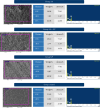An In Vitro Comparison of the Influence of Air Abrasion, G-Multiprimer, and Salivary Contamination on the Shear Bond Strength and Surface Characteristics of Opaque Zirconia Ceramics
- PMID: 40551785
- PMCID: PMC12185196
- DOI: 10.1155/ijod/3644666
An In Vitro Comparison of the Influence of Air Abrasion, G-Multiprimer, and Salivary Contamination on the Shear Bond Strength and Surface Characteristics of Opaque Zirconia Ceramics
Abstract
Aim: To evaluate the effect of various surface treatments and saliva contamination on the shear bond strength (SBS) and surface characteristics of yttria-stabilized tetragonal zirconia ceramics (YTZP) bonded with self-adhesive resin cement (SAC). Materials and Methods: Opaque Y-ZTP ceramics were divided into four groups based on specific surface treatment: control (C), air abrasion (AA), G-multiprimer (G), and AA + G (AG). Surface characteristics of the treated specimens, roughness and, elemental analysis were done using scanning electron microscopy (SEM), atomic force microscopy (AFM), and energy dispersive analysis of X-rays (EDAX), respectively. These specimens were further divided into saliva (S) and non-S (NS) contamination groups. Following the surface treatment, 10 resin cement cylinders were affixed onto the zirconia discs within every group. Micro-SBS (µSBS) was calculated, and fracture surfaces were assessed. Statistical analysis was done using one-way analysis of variance (ANOVA) and the post hoc Tukey test. Results: The µSBS values for the groups were as follows: CS (0.86 ± 0.7), CNS (3.13 ± 2.7), AS (3.14 ± 2.6), ANS (2.96 ± 1.2), GS (5.92 ± 2.2), GNS (5.94 ± 2.2), AGS (4.97 ± 0.9), and AGNS (8.06 ± 1.4). A one-way ANOVA showed that all the groups had a statistically significant difference in the SBS except the AS, AGS, CNS, ANS, as well as the GNS and AGNS. AFM results revealed the mean roughness value of AA is highest, followed by G-multiprimer, AG, and least in control. This difference is statistically significant with p-value of <0.001. This also correlated with the SEM images. Conclusion: Airborne particle abrasion and the application of G-multiprimer provide the best results in a moisture-free environment.
Keywords: G-multiprimer; air abrasion; resin cement; saliva contamination; zirconia.
Copyright © 2025 Alisha Ono Idris et al. International Journal of Dentistry published by John Wiley & Sons Ltd.
Conflict of interest statement
The authors declare no conflicts of interest.
Figures




Similar articles
-
Effects of honeycomb surfaces on bond strength to zirconia fabricated with 3-dimensional printing.J Prosthet Dent. 2025 Jul;134(1):226.e1-226.e9. doi: 10.1016/j.prosdent.2025.03.023. Epub 2025 Apr 4. J Prosthet Dent. 2025. PMID: 40187902
-
Influence of bionic microstructures on the bond strength of additively manufactured zirconia.J Prosthet Dent. 2025 Jul 4:S0022-3913(25)00542-6. doi: 10.1016/j.prosdent.2025.06.019. Online ahead of print. J Prosthet Dent. 2025. PMID: 40617760
-
Effect of Different Concentrations of Nano Hydroxyapatite on the Microshear Bond Strength of Zirconia to Resin Cement.Int J Prosthodont. 2025 Jun 20;0(0):1-21. doi: 10.11607/ijp.9205. Online ahead of print. Int J Prosthodont. 2025. PMID: 40540639
-
Effect of laser irradiation on bond strength between zirconia and resin cement or veneer ceramic: A systematic review and meta-analysis.J Indian Prosthodont Soc. 2021 Apr-Jun;21(2):125-137. doi: 10.4103/jips.jips_590_20. J Indian Prosthodont Soc. 2021. PMID: 33938862 Free PMC article.
-
Systemic pharmacological treatments for chronic plaque psoriasis: a network meta-analysis.Cochrane Database Syst Rev. 2021 Apr 19;4(4):CD011535. doi: 10.1002/14651858.CD011535.pub4. Cochrane Database Syst Rev. 2021. Update in: Cochrane Database Syst Rev. 2022 May 23;5:CD011535. doi: 10.1002/14651858.CD011535.pub5. PMID: 33871055 Free PMC article. Updated.
References
-
- Tan P. L., Gratton D. G., Diaz-Arnold A. M., Holmes D. C. An In Vitro Comparison of Vertical Marginal Gaps of CAD/CAM Titanium and Conventional Cast Restorations. Journal of Prosthodontics-Implant Esthetic and Reconstructive Dentistry . 2008;17(5):378–383. doi: 10.1111/j.1532-849X.2008.00302.x. - DOI - PubMed
LinkOut - more resources
Full Text Sources
Research Materials
Miscellaneous

